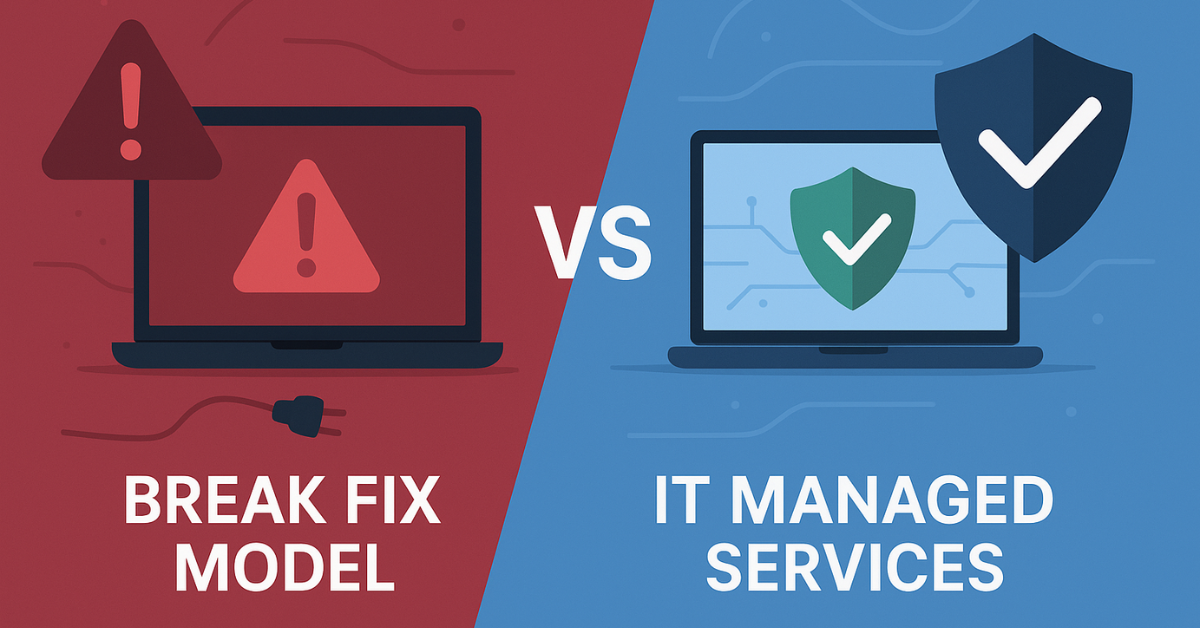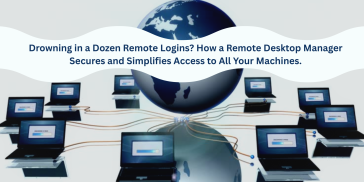In the present business landscape, IT Managed Services is not only a supportive function but the central part of an organization. It facilitates communication, drives transformation, manages data, and enables operational processes. Additionally, this approach is a business takes to maintain and manage its IT infrastructure. It is critical to determine its efficiency, security, and long-term financial health.
Over several years, the predominant model was the Break-Fix approach. A reactive methodology where IT support is engaged only when a system fails. Moreover, a paradigm shift is underway in organizations that are increasingly migrating to proactive IT Managed services. This transition is not a trend but a strategic financial and operational imperative.
This article will carefully break down the deep and often overlooked hidden costs of the Break-Fix model and explain how a proactive Managed Services Provider (MSP) framework can save a lot of money and provide better value.
Cost of the Break-Fix Model
Initially, the Break-Fix Model makes sense financially. And this idea is simple because the business only pays for IT support when it needs it. There is no monthly fee, so it seems like it costs something. And small businesses and new companies that don’t have a lot of money to start with really like this pay-as-you-go model. But this perceived low cost is a scam that hides a complicated web of direct and indirect costs that can have a big effect on a business’s bottom line and stability.
Hidden Costs in Break-Fix
The true cost of Break-Fix IT extends far beyond the hourly rate of an IT services provider. These hidden costs are obvious in several critical areas.
-
Random and Catastrophic Expenditure:
For sure, cost is the main problem of every organization. Suppose Break-Fix costs are not set, so it’s not a big problem. A firm can easily change at any time, often when there is a major system failure. There is no warning for a server crash, ransomware attack, or a major network outage. The bill for emergency repairs usually includes high rates for work that is completed after hours, expensive replacement parts, and high labor costs. It cannot be good for an organization’s finances. It can be very stressful on your budget and even take money away from important things like marketing or research and development.
-
Downtime and Productivity:
In this model, the clock on downtime starts to indicate the moment when most failure occurs. And it only stops when the technician arrives and identifies the issue, sources any necessary parts, and performs the repair. This process can take a few hours. The cost of this downtime is complicated and includes:
-
-
Lost Employee Productivity:
In any firm where employees who can’t get to systems, email, or data are basically doing nothing. The cost is figured out by multiplying the number of affected employees by the average hourly wage and the number of hours of downtime. For a company with 50 employees, even a half-day outage can mean thousands of dollars in lost wages for work that isn’t getting done.
-
Lost Revenue Generation:
As the e-commerce platforms fully rely on the online booking system that customers use. Where downtime means lost sales and shopping carts, as people do not complete their shopping process. This damage to income streams is immediate and easy to measure.
-
Operational Stagnation:
If Production lines stop, deliveries are late, and service delivery is affected, which has an adverse effect throughout the company and its supply chain.
-
-
Cost & Data Loss:
In a reactive approach, IT provides no guarantees of robust, regularly tested data backups. When a malware attack occurs or hardware fails, the risk of data loss is high. To recover from such an event without a backup is not technically challenging, but excessively expensive. All business firms deserve professional data recovery services, which save thousands of dollars. The lost data, which could be trademarks, finances, or client information, could be worth a lot and could even put the business’s future in danger.
-
Cybersecurity Vulnerabilities:
As you know, this break-fox model is not always safe. Let’s suppose that IT professionals don’t keep the system updated or safe from threats. On this point, cybersecurity can easily get into systems that use outdated software with vulnerabilities. The cost of a single security breach can be much higher than the years of savings you think you will get from the Break-Fix model. This includes fines from regulators, legal fees, ransomware payments, credit monitoring services for affected customers, and huge damage to your reputation.
-
Inefficient IT Spending and Lack of Strategic Planning:
Obviously, without strategic planning and professional IT services, businesses make poor decisions and IT networks. What happens mostly in this scenario? Usually, they purchase useless hardware materials, under specific solutions that lead to permanent failure. And one more thing that we see in most organizations is over-investment in unused capacity. These common mistakes that a firm is making continuously without planning because the firm does not adopt a technical roadmap that aligns with IT business goals.
-
Employee Morale and IT Staff Burnout:
The Break-Fix model is such that it sets out issues all the time for businesses that only have a few IT professionals on staff. That is a burden on the IT professionals to manage a lot of tasks in a minimum time. These things bring down your staff’s morale and energy. They don’t feel as excited to come to work the next day, and because of that, their performance and productivity become low. Also, when non-IT workers must use technology that does not work.
Proactive Paradigm of Managed IT Services
The Proactive Managed Services model represents a fundamental shift from a transactional, incident-based relationship to a strategic, partnership-oriented one. An organization contracts with a Managed Services Provider (MSP) for a comprehensive suite of IT management, monitoring, and support services, typically for a fixed monthly subscription fee. This model is predicated on the principle of prevention rather than cure.
Core Components of a Managed Services Agreement (MSA):
A strong MSA typically includes:
-
24/7/365 Continuous Monitoring and Maintenance:
Advanced tools are used in monitoring all network parts, such as servers, workstations, firewalls, and storage. This lets you identify hardware failures, low disc space, or strange network traffic.
-
Patch Management and Security Updates:
Managed service providers assume responsibility for systematically deploying security patches. Additionally, software updates across the entire network are made, and make sure vulnerabilities are promptly addressed IT environment remains secure.
-
Proactive Maintenance and Performance Optimization:
At this point, regular tasks such as disk defragmentation, log reviews, and system optimization are performed. It automatically keeps systems running at peak efficiency and extends their operational lifetime.
-
Data Backup and Disaster Recovery (BDR):
A cornerstone of this model, it includes automation, regular test backups of all authentic and critical data. A modern BDR certifies the recovery of data and the system event of a disaster. It minimizes downtime to hours or minutes rather than days.
-
Help Desk and Technical Support:
A dedicated help desk service is available to all employees of the company to quickly fix everyday technical problems. This stops small problems from turning into big ones.
-
Strategic Technology Consulting (vCIO):
The MSP acts as a virtual Chief Information Officer (vCIO), providing strategic guidance, budgeting assistance, and technology roadmaps that align IT investments with the client’s business objectives.
A Comparative Analysis – A Hypothetical Scenario
| Scenario | Break-Fix Model | Managed Services Model |
| Year 1 | Minor issues cost $5,000. It looks like savings at first. | Proactive monitoring catches a failing server fan — replaced early. Zero downtime. |
| Year 2 | If the server fails on a critical day. Repair $8,000 + downtime loss $36,000 + lost sales $15,000 = $59,000 total. | Zero-day virus blocked by MSP’s security system. No downtime or loss. |
| Year 3 | Ransomware attack: $50,000 ransom + 3 days downtime ($100,000+ losses) + reputational harm. | Deleted financial file restored in 15 minutes from backup. Zero loss. |
| Total Cost | Over $160,000+ with major risks and downtime. | Fixed $75,000 per year (total $225,000) with no downtime or data loss. |
| Overall Outcome | Reactive, costly, stressful, and risky. | Predictable costs, stable operations, and peace of mind. |
In Year 1, the Break-Fix model seemed cheaper, but its unstable nature posed existential threats in the years that followed. The MSP model provides predictable cost values, continuous uptime, and strong security. That ultimate saves advances innovation from financial and operational catastrophe. The $75k annual fee is not an expense but a strategic investment in business continuity and risk avoidance. Remember, these prices are random in MSP for just for comparison purposes only.
Conclusion
Now it’s your choice between Break-Fix IT and proactive managed services, because these two different ways of doing business. The Break-Fix model is a short-sighted, reactive approach that doesn’t work because of hidden costs like downtime, data loss, security breaches, and operational inefficiency. It is a costly choice that could put the whole company at risk.
On the other hand, the proactive managed services model is a smart and strategic choice. It highlights stability, security, and alignment with business goals first. If someone can turn unpredictable, costly IT spending into predictable operational costs. It means they will not only have a better understanding of their finances, but they will also have a competitive edge. The savings that come from avoiding disasters, which boost productivity, extend the lifespan of assets, and give employees the tools they need to get a better return on investment. In this time when we all rely on technology, moving to a proactive IT management framework is no longer just for big companies. Any business that wants to make sure it can get through tough times, protect its future, and stay focused on its main goal of growth should have this plan.
We hope the information we share is helpful and reliable for you. If you need any more guidance or have questions about this topic, you can contact us anytime.




